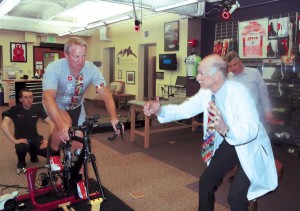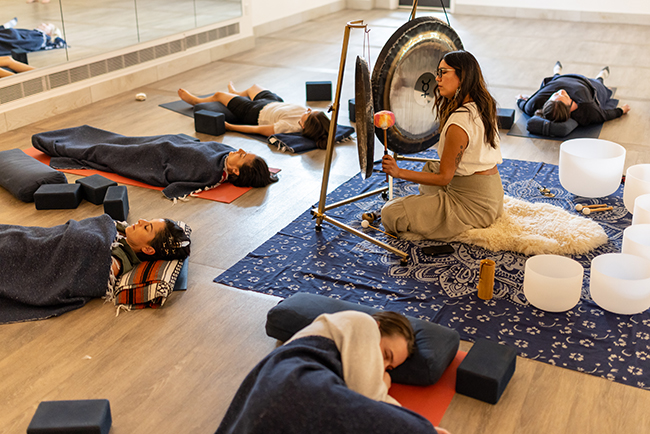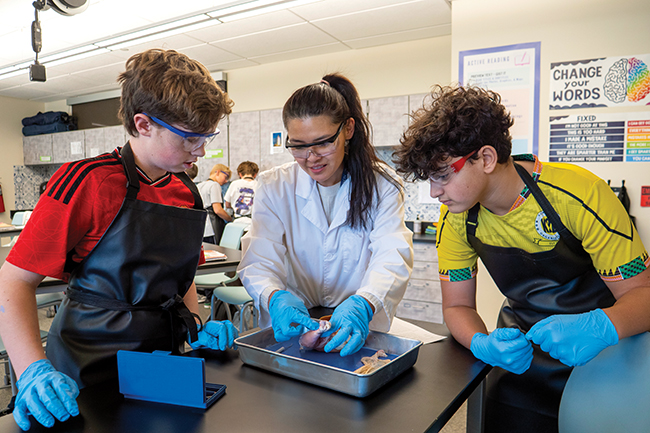Need a New Knee?
26 Jun 2015
Get a second opinion, and ask around
In the late 1960s, getting a new knee might have seemed risky. But it’s been almost 50 years since the first knee replacement, and today the procedure is performed more than 700,000 times a year in the United States. (Given Boulder’s active and aging population, we may account for a good many of those.) Yet though knee arthroplasty, or replacement, is now routine surgery, roughly one out of six patients still isn’t happy with the outcome. One very satisfied customer, Kyle Moore, jokes that she doesn’t remember which knee was replaced unless she looks for the scar. Moore, 57, is the recipient of a customized total knee replacement performed by Michael Wertz, M.D., an orthopedic surgeon at Boulder Bone and Joint, who started doing custom implants last July. Normally, surgeons choose from a range of sizes of “off-the-shelf” implants, but the “iTotal” implant is patient-specific, based on a patient’s bone geometry. CT scans and 3-D printing technology are used to create a wax mold, one sub-millimeter at a time, for a femoral implant as well as for customized jigs (plastic cutting guides). The implants, also made for partial knee replacements, are manufactured by the Boston-based company ConforMIS. Because the implant is personalized, the wait is a bit longer—eight weeks—but the precise fit pays off with a natural feel, Wertz says. “Most ConforMIS patients are progressing more rapidly with their range of motion, weight bearing and function than my patients with off-the-shelf knees.” Another benefit, he says, is the need for fewer trays of surgical instruments, which means a cleaner “back table” in the operating room and fewer instruments to sterilize. Wertz, the only surgeon using ConforMIS in the Boulder area, has put in about 35 iTotal knees, and the customized implants now account for roughly 90 percent of his knee replacements. The other 10 percent of patients aren’t candidates, he says, because their bone damage is too extensive.Evolving with the Technology
Many factors contribute to a successful knee replacement, says Michael Repine, M.D., a general orthopedist at Boulder Medical Center, who performs hip and knee replacements. Number one, he says, is patient education, to ensure that people understand what a partial or full replacement can give them. Repine also underscores the role of proper rehab. He says, laughing, “I can put the knee in backwards and I think if somebody rehabs it well, the patient will do very well.” Brian Blackwood, M.D., an orthopedic surgeon at Mapleton Hill Orthopaedics who focuses on hips and knees, points to a poll of surgeons that names ligament balancing and surgeon skill as the top considerations. (He wouldn’t put customized implants on the list.) But Repine and Blackwood agree that it’s important to evolve with technology, and there are plenty of innovative joint-replacement technologies on the market. To balance ligaments with precision, Blackwood uses a “smart trial” sensor produced by OrthoSensor. Midway through surgery, a disposable sensor is temporarily inserted to provide real-time quantitative feedback about joint tracking and soft-tissue balancing. (OrthoSensor is advertising a permanent implantable sensor, still in development, that will wirelessly send postoperative information to doctors.) Precision is also increasing with robotic-assisted procedures and computer navigation. Both Blackwood and Repine use MAKOplasty, a robotic arm that aids in the precise removal of damaged bone, on both partial knee and hip replacements. (It’s close, but not here yet, for total knees.) A quick online search yields other innovative technologies. “I love the scientific elements of [the technology], and I think people should push the boundaries and see what’s bigger, what’s better,” Repine says. “But I can adjust millimeter by millimeter in a semi-custom fit without difficulty. I think that patients with unusual or atypical anatomy may benefit from a custom implant. But I think correct balancing of the components is much more critical to the success of the surgery. You can chase numbers into the microscopic realm; I just don’t think it makes a mechanical difference.” The American Association of Knee and Hip Surgeons doesn’t take sides. It says in a statement, “To date, there appears to be both pros and cons to each of these technologies, but more research is required to determine what advantage, if any, these may offer.”Ee-knee, Mee-knee
If a new joint is in your near future and considering options is leaving you a little weak in the knees, Blackwood says to focus on the surgeon, not the technology. Keep in mind that more surgical experience is correlated with fewer complications. A common rule of thumb is to go with a doctor who completes at least 50 knee replacements per year and a hospital that performs at least 200 a year. Get a second opinion, and ask around. “If you’re in the market for a joint replacement, you’re likely in the age group with peers who’ve had joint replacements,” says Blackwood. Repine offers another consideration: “You have to pick a surgeon you’re willing to make a bond with, because having a joint replacement is not so much a two-minute procedure. You need to feel confident in their ability to carry you not only through the surgery but through the rehab process and through the years afterward.” Currently, knee replacements last around 15 to 20 years. Bottom line, says Blackwood: “Go with someone you trust.”‘Cruel and Barbaric’?
Repine thinks that while knee replacements will continue to improve, arthroplasty will someday become a thing of the past. “I think stem cells are the direction we’re going to go,” he says, explaining that he believes stem cells will enable us to turn back time and regrow cartilage. “It will be like Star Trek technology. You won’t need to cut and replace the knee. That would seem cruel and barbaric.” But though we’re still a long way from stem-cell injections on the Enterprise, Moore feels like a million bucks. “I feel like I could do anything,” she says, reeling off adventures she’s contemplating, including Cycling the Great Divide, a mountain bike ride from Canada to Mexico. When Moore says she also plans to cross “parachuting” off her bucket list, Wertz winces. He’s confident in Moore’s new knee, he says, but not parachutes. (He’s an orthopedic surgeon, after all.) Moore laughs: “Maybe I’ll put that off to my later years.” --By Shannon BurgertUp and At ‘Em
After 10 years of pain, Boulder realtor Duane Duggan had both his “shot” knees replaced last fall in surgeries performed by Dr. Michael Wertz. “They get you on a stationary bike the day after surgery,” he says. “It’s pretty damn incredible. For day-to-day life, I was pretty happy as soon as the stitches came out.” An avid cyclist who likes to ride 60 or 80 miles a week, Duggan (above, in gray T-shirt) consulted with “bike-fitting guru” Dr. Andy Pruitt (in white coat), and now can handle a ride up to Ward with 6,000 feet of elevation gain; a ski fit will be next.
“I’m just like Steve Austin in The Six Million Dollar Man,” he says. “I don’t expect to go cliff jumping and mogul bashing—but at 60 you’re more sane than you were before.”
—Mary Jarrett
An avid cyclist who likes to ride 60 or 80 miles a week, Duggan (above, in gray T-shirt) consulted with “bike-fitting guru” Dr. Andy Pruitt (in white coat), and now can handle a ride up to Ward with 6,000 feet of elevation gain; a ski fit will be next.
“I’m just like Steve Austin in The Six Million Dollar Man,” he says. “I don’t expect to go cliff jumping and mogul bashing—but at 60 you’re more sane than you were before.”
—Mary Jarrett












